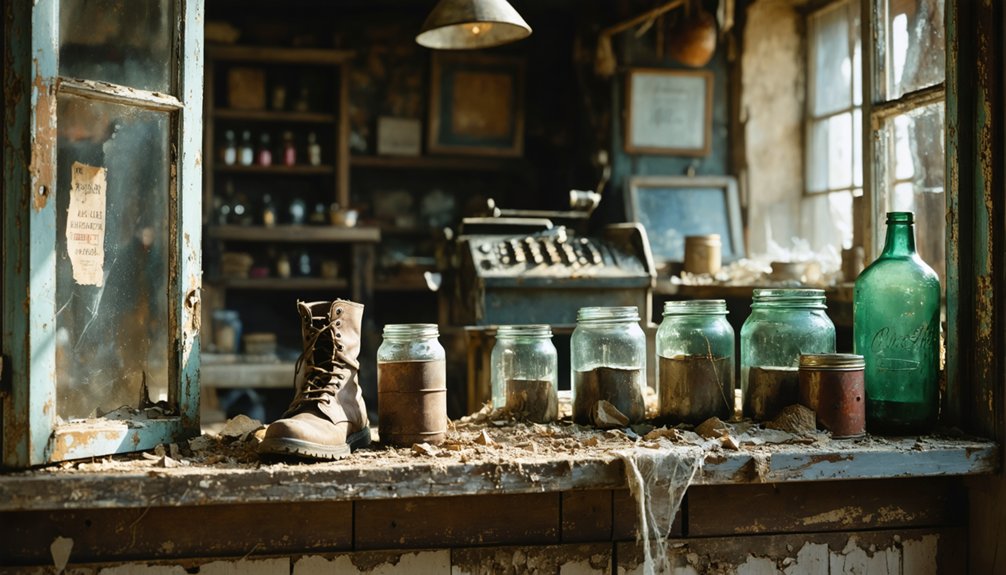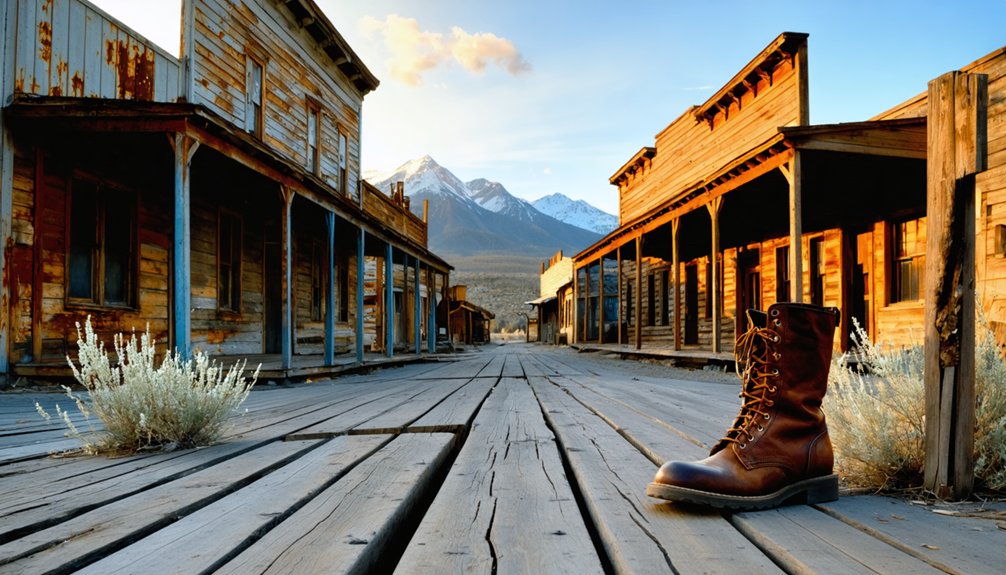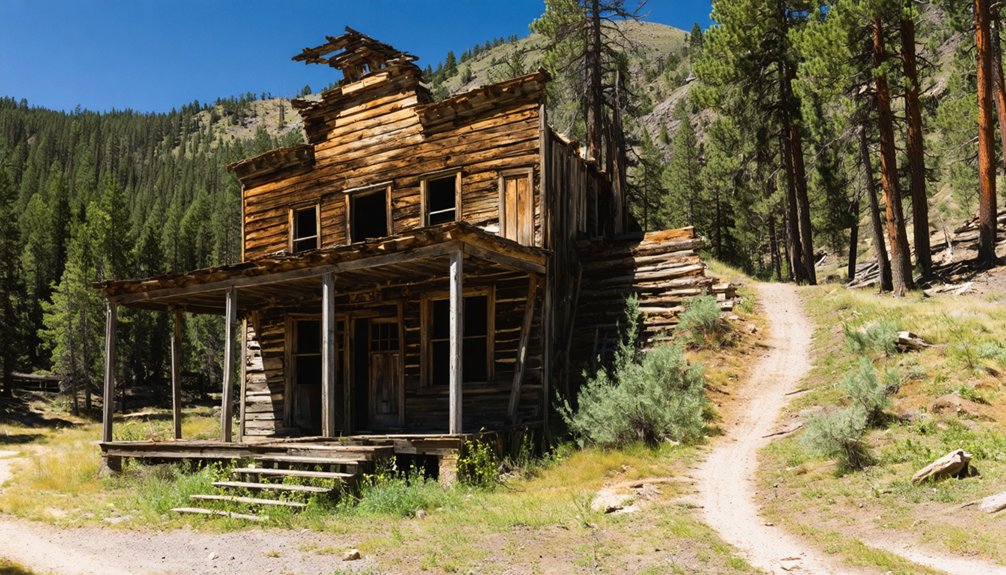You’ll discover Deadwood City as a remote Idaho County ghost town established in 1867 when prospector Nathan Smith founded the Deadwood placer mining district. Though short-lived, the site yielded impressive gold values of up to $2 per pan across various gulches, attracting fortune seekers who built hasty wooden shelters and primitive mining operations. By 1869, most miners had abandoned their claims for richer prospects at Loon Creek, leaving behind weathered cabins and gravity-fed mill remnants that tell a compelling frontier tale.
Key Takeaways
- Deadwood City was established in 1867 as a mining settlement in Idaho after Nathan Smith’s discovery sparked a gold rush.
- The town experienced brief prosperity with gold values up to $2 per pan before most miners abandoned it by 1869.
- Mining operations utilized gravity-fed mills and innovative processing methods, leaving remnants still visible in the ghost town today.
- The site contains preserved ruins of stamp mills, mining structures, and weathered cabins chronicling Idaho’s frontier mining history.
- Located in remote terrain within dense forest, the ghost town requires survival gear and careful navigation for modern-day exploration.
The Birth of a Mining Settlement
While gold had lured prospectors to many parts of Idaho Territory in the 1860s, the Deadwood mining area remained largely unexplored until the 1880s. That changed when Nathan Smith arrived from Idaho, bringing mining innovation to the untapped region. His efforts led to a pivotal miners’ meeting in August 1867, establishing the Deadwood placer mining district and launching systematic operations. The miners later established a gravity-fed mill design to improve their efficiency.
You’ll find that early prospectors’ challenges were well rewarded, with gold values reaching up to $2 per pan across multiple gulches. Companies achieved remarkable success, with some earning $5,000 in two weeks.
The discovery of high-grade lead, silver, and gold ore sparked a rush of claim stakes. Soon, determined miners were working fissure veins embedded in granite, where quartz veins averaging two feet wide yielded silver content up to 212 ounces per ton.
Gold Rush Fever and Early Prosperity
When placer gold was discovered in Deadwood Basin during the early summer of 1863, prospectors rushed to stake their claims in what would become one of Idaho Territory’s promising mining settlements.
Gold’s glitter in Deadwood Basin sparked a rush of hopeful prospectors to Idaho Territory’s newest mining frontier in 1863.
You’d have found the early mining activity focused on simple placer mining methods, with miners working creek beds and gulches for loose gold particles mixed with soil and rock.
Like the Homestake Mine discovery in the Black Hills, many prospectors dreamed of finding the next major gold deposit that could produce for decades to come.
The real fever struck in 1867 when news spread of yields reaching up to $2 per pan from Idaho City.
This second wave brought a stampede of fortune-seekers who established a formal mining district that August.
By 1868, ambitious miners began exploring quartz discoveries and lead-zinc deposits, though these required more substantial investment.
The prosperity wouldn’t last – by 1869, miners began abandoning Deadwood for Loon Creek’s richer prospects.
Mining Operations and Techniques
As mining operations intensified at Deadwood during the late 1860s, the site’s infrastructure expanded to include sophisticated ore processing facilities capable of handling 100 tons per day.
Like many Idaho mining operations of the era, these techniques caused significant mercury contamination in the surrounding environment.
The site was classified as a Producer within the Elk City District of Idaho County.
You’ll find evidence of the complex milling techniques in the remnants of the gravity-fed system that once processed silver-lead-zinc ores through multiple crushing stages.
The operation used a storage-battery locomotive pulling ten cars underground to deliver ore to a 250-ton crude-ore bin. From there, you can trace how the ore moved through a Blake crusher, impact screen, and Symons cone crusher before reaching the 300-ton fine ore bin.
Later innovations included heap leach and Merrill-Crowe processing methods, which allowed miners to extract precious metals from lower-grade ores more efficiently than their predecessors could have imagined.
The Deadwood Basin’s Rich Resources
Located within Idaho’s complex geological framework, the Deadwood Basin harbors a remarkable concentration of mineral resources shaped by Mesozoic and early Tertiary formations.
You’ll find an impressive range of geological formations, including granocliorite and diorite, interspersed with porphyritic rocks that create the basin’s distinctive character. The area’s mineral diversity stems from ancient volcanic activity and structural weaknesses that facilitated mineral-rich intrusions.
The basin’s resources extend beyond its famous gold deposits, which you can explore at sites like the Merry Blue Mine. The Valley County location provides a distinctive geological setting for these mineral formations.
The Deadwood River and Reservoir system sustains both the natural ecosystem and local agriculture, while the region’s mining heritage continues to draw visitors. These varied resources have supported communities throughout history, from the early mining boom to today’s conservation efforts.
Life in the Boomtown Years
If you’d visited Deadwood City during its peak years, you’d have found miners working from dawn to dusk, panning gold in the gulches for yields reaching $2 per pan.
The social scene centered around miners’ meetings where claims were organized and disputes settled, while basic provisions came from nearby Idaho City. Like other boomtowns of the era, the atmosphere was marked by rough and violent culture.
Your lodging options would have included simple log cabins along the roads, with many miners constructing their own temporary shelters near their claims. The discovery of rich gold deposits in the Black Hills had drawn thousands of eager prospectors to the region.
Daily Mining Camp Life
The rugged life in Deadwood’s mining camp revolved around intense daily labor, with miners working grueling shifts for $4 per day during the peak operations of the late 1860s.
You’d find camp camaraderie developing among workers as they tackled challenging mining routines, from placer operations to quartz vein extraction. Chinese laborers joined the workforce by 1872, bringing diversity to the camp’s social fabric.
- Stamp mills crushed ore using gravity-fed systems, with workers processing up to 20 tons daily.
- Mining seasons were dictated by water availability, affecting the camp’s work rhythm.
- Miners lived in purpose-built cabins near the work sites, creating tight-knit communities.
- Daily tasks included tunnel expansion, vein development, and careful assessment of quartz yields.
Gold Rush Social Scene
During Deadwood’s heyday, three prominent saloons anchored the town’s vibrant social scene, serving as bustling community hubs where miners gathered after grueling shifts to try their luck at cards, share tales of their latest strikes, or catch touring theatrical shows.
You’d find social gatherings of every sort, from impromptu storytelling sessions to organized miners’ meetings where local figures like Nathan Smith and James H. Hawley helped shape community dynamics.
The post office and general store buzzed with news and gossip, while gambling halls drew both prospectors and notorious gunslingers. Legendary gunslinger Wild Bill Hickok met his fate here while playing poker in 1876.
While law enforcement remained sparse, fraternal organizations and religious groups emerged to provide structure amid the chaos.
Wealth disparities created distinct social hierarchies, with successful claim holders mixing uneasily alongside struggling miners in this raw, unfettered frontier environment.
Living Quarters and Supplies
Living conditions in Deadwood City reflected the harsh realities of frontier boomtown life, where hastily constructed wooden shelters housed an ever-growing population of fortune seekers.
You’d face severe housing shortages, with multiple miners often sharing cramped quarters at inflated prices. Supply challenges meant you’d pay premium rates for basic necessities at the trading posts, while fresh food remained scarce due to limited transportation options. Like many early boomtowns, the rapid population growth overwhelmed the limited housing and services available.
- Your shelter might be little more than a rough-hewn cabin with minimal protection from the elements.
- You’d rely heavily on preserved foods and struggle to access fresh produce or meat.
- Daily survival meant dealing with unreliable infrastructure and primitive sanitation.
- Trading posts became essential lifelines, though supplies often ran short during harsh weather.
The Great Exodus and Decline

After experiencing its initial mining boom in the late 1860s, Deadwood City’s promising future began to crumble as economic and infrastructural challenges mounted.
You would’ve witnessed dramatic population dynamics as miners, who once extracted up to $1 per pan, abandoned their claims in search of richer deposits elsewhere.
The economic shifts proved harsh – costly reduction plants and mills strained resources, while the area’s remote location and rugged terrain made sustaining operations nearly impossible.
Tales of Two Deadwoods
While two frontier towns shared the name Deadwood in America’s mining era, their destinies couldn’t have been more different.
The cultural differences between Idaho’s short-lived mining camp and South Dakota’s enduring boomtown tell a tale of contrasting frontier experiences. Idaho’s Deadwood remains a reflection of the fleeting nature of Western mining myths, marked by scattered ruins and forgotten stories. In contrast, South Dakota’s Deadwood transformed its wild history into lasting legend.
- Idaho’s Deadwood peaked in 1867, producing modest yields before miners abandoned it for richer strikes.
- South Dakota’s Deadwood attracted 12,000 residents by 1877, spawning legendary tales of Wild Bill and Calamity Jane.
- Idaho’s site features untouched ruins of stamp mills and miner cabins.
- South Dakota’s preserved buildings and saloons anchor a modern tourist destination with legalized gambling.
Preserved Remnants and Historical Sites

Today’s visitors to Deadwood City encounter a compelling array of preserved mining structures that chronicle Idaho’s frontier ambitions.
You’ll find the mine buildings tucked behind Deadwood Lodge, with several weathered miner cabins dotting the road below. These preservation efforts showcase the site’s historical significance, offering you a tangible connection to the region’s mining heritage.
The office and mill, captured in 1930s photographs, stand as evidence to the area’s industrial past.
While exploring these remnants, you’ll witness the gravity-fed mill system that once processed ore yielding 62 ounces per ton.
These architectural survivors, documented by the Idaho State Historical Society, provide you with an authentic window into the determined spirit of 19th-century prospectors who sought their fortunes in Valley County’s rugged terrain.
Modern-Day Ghost Town Adventures
Visitors starting on a Deadwood City adventure must prepare for a truly remote ghost town experience.
You’ll find yourself surrounded by dense forest and rugged terrain, where decaying mine buildings and weathered cabins create ideal opportunities for ghost town photography. The isolation adds authenticity to your outdoor exploration, with natural sounds replacing modern noise pollution.
- Pack essential survival gear – you’re hours from the nearest services in Cascade or McCall
- Bring reliable navigation tools, as cell service is virtually nonexistent
- Consider a satellite communicator for emergencies
- Plan your visit between late spring and early fall for favorable conditions
Your self-guided journey through Deadwood City requires a high-clearance vehicle and complete self-sufficiency.
The lack of organized tours means you’re free to explore at your own pace, though you’ll need to exercise caution around unstable structures and mine entrances.
Frequently Asked Questions
What Was the Highest Recorded Population of Deadwood City During Its Peak?
You’ll find no exact records of peak population during the mining boom, though population growth surged briefly in 1867 before quickly declining as miners abandoned their claims in 1869.
Were There Any Notable Crimes or Shootouts in Deadwood City?
You won’t find documented gunfight history or significant criminal activities in this town’s records. While mining disputes likely occurred, there’s no concrete evidence of notable shootouts or major crimes.
What Happened to Nathan Smith After the Mining Camp’s Decline?
After Deadwood’s decline, you’ll find Smith moved on to discover gold at Loon Creek in 1876. Beyond that, his later years aren’t well documented, though his legacy endures as Idaho’s distinguished frontier prospector.
Did Any Indigenous Tribes Have Conflicts With the Deadwood City Settlers?
You’ll find records of indigenous tribes, including Nez Perce, Bannock, and Paiute, engaging in conflicts with Deadwood City settlers during the broader regional struggles over territory and resources in the 1870s.
Was There Ever an Attempt to Establish a Railroad Connection?
While you might expect railroad expansion given the mining transportation needs, historical records don’t confirm any actual railroad attempts to Deadwood City, Idaho. Supplies were hauled by difficult road routes instead.
References
- https://www.blackhillsvacations.com/things-to-do/experience-the-black-hills/historic-deadwood/
- https://www.deadwood.com/history/
- https://allthatsinteresting.com/wild-west-mining-towns
- https://yellowpinetimes.wordpress.com/2017/09/10/idaho-history-sep-10/
- https://www.idahogeology.org/pub/Staff_Reports/2007/Staff_Report_07-2.pdf
- https://www.ghosttowns.com/states/id/deadwoodcity.html
- https://www.youtube.com/watch?v=j3Q7DgOtJeY
- https://www.rvtravel.com/deadwood-mine-mysterious-vault-geraldo-rivera-1119/
- https://history.idaho.gov/wp-content/uploads/0223_Deadwood.pdf
- https://www.idahogeology.org/pub/Pamphlets/P-131.pdf



